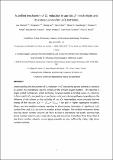The role of LiO2 solubility in O2 reduction in aprotic solvents and its consequences for Li-O2 batteries
Abstract
When lithium–oxygen batteries discharge, O2 is reduced at the cathode to form solid Li2O2. Understanding the fundamental mechanism of O2 reduction in aprotic solvents is therefore essential to realizing their technological potential. Two different models have been proposed for Li2O2 formation, involving either solution or electrode surface routes. Here, we describe a single unified mechanism, which, unlike previous models, can explain O2 reduction across the whole range of solvents and for which the two previous models are limiting cases. We observe that the solvent influences O2 reduction through its effect on the solubility of LiO2, or, more precisely, the free energy of the reaction LiO2* ⇌ Li(sol)+ + O2−(sol) + ion pairs + higher aggregates (clusters). The unified mechanism shows that low-donor-number solvents are likely to lead to premature cell death, and that the future direction of research for lithium–oxygen batteries should focus on the search for new, stable, high-donor-number electrolytes, because they can support higher capacities and can better sustain discharge.
Citation
Johnson , L , Li , C , Liu , Z , Chen , Y , Freunberger , S A , Ashok , P C , Praveen , B B , Dholakia , K , Tarascon , J-M & Bruce , P G 2014 , ' The role of LiO 2 solubility in O 2 reduction in aprotic solvents and its consequences for Li-O 2 batteries ' , Nature Chemistry , vol. 6 , no. 12 , pp. 1091-1099 . https://doi.org/10.1038/nchem.2101
Publication
Nature Chemistry
Status
Peer reviewed
ISSN
1755-4330Type
Journal article
Description
P.G.B. acknowledges financial support from the Engineering and Physical Sciences Research Council (including the SUPERGEN programme). S.A.F. acknowledges financial support from the Austrian Federal Ministry of Economy, Family and Youth and the Austrian National Foundation for Research, Technology and Development as well as the Austrian Science Fund (FWF): P26870-N19. K.D. thanks the UK EPSRC for funding and the European Union project FAMOS (FP7 ICT, contract no. 317744).Collections
Items in the St Andrews Research Repository are protected by copyright, with all rights reserved, unless otherwise indicated.

